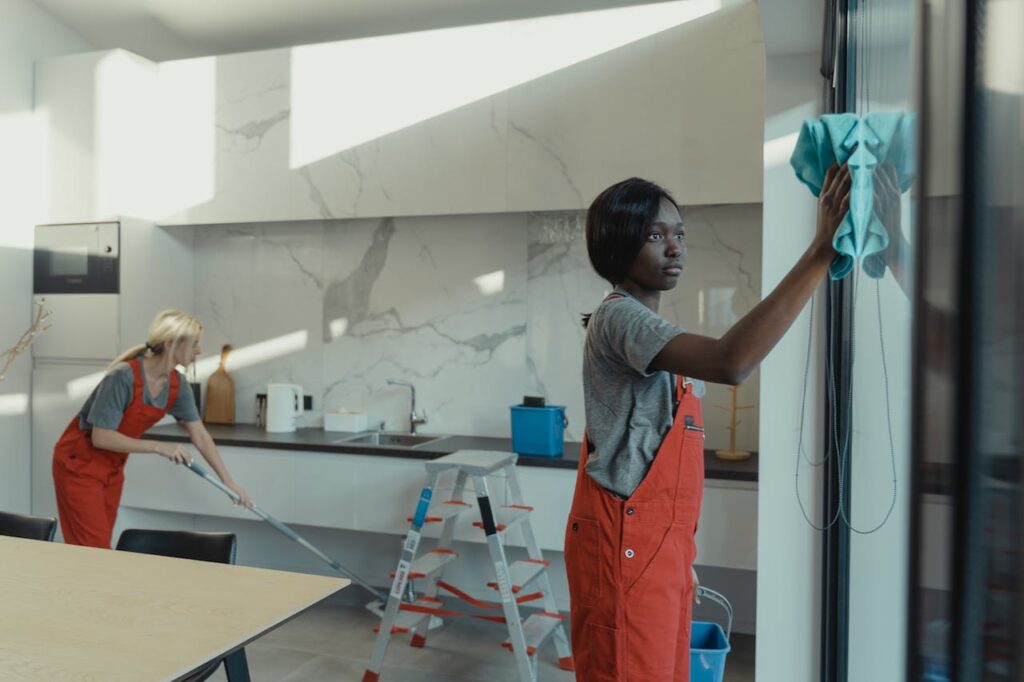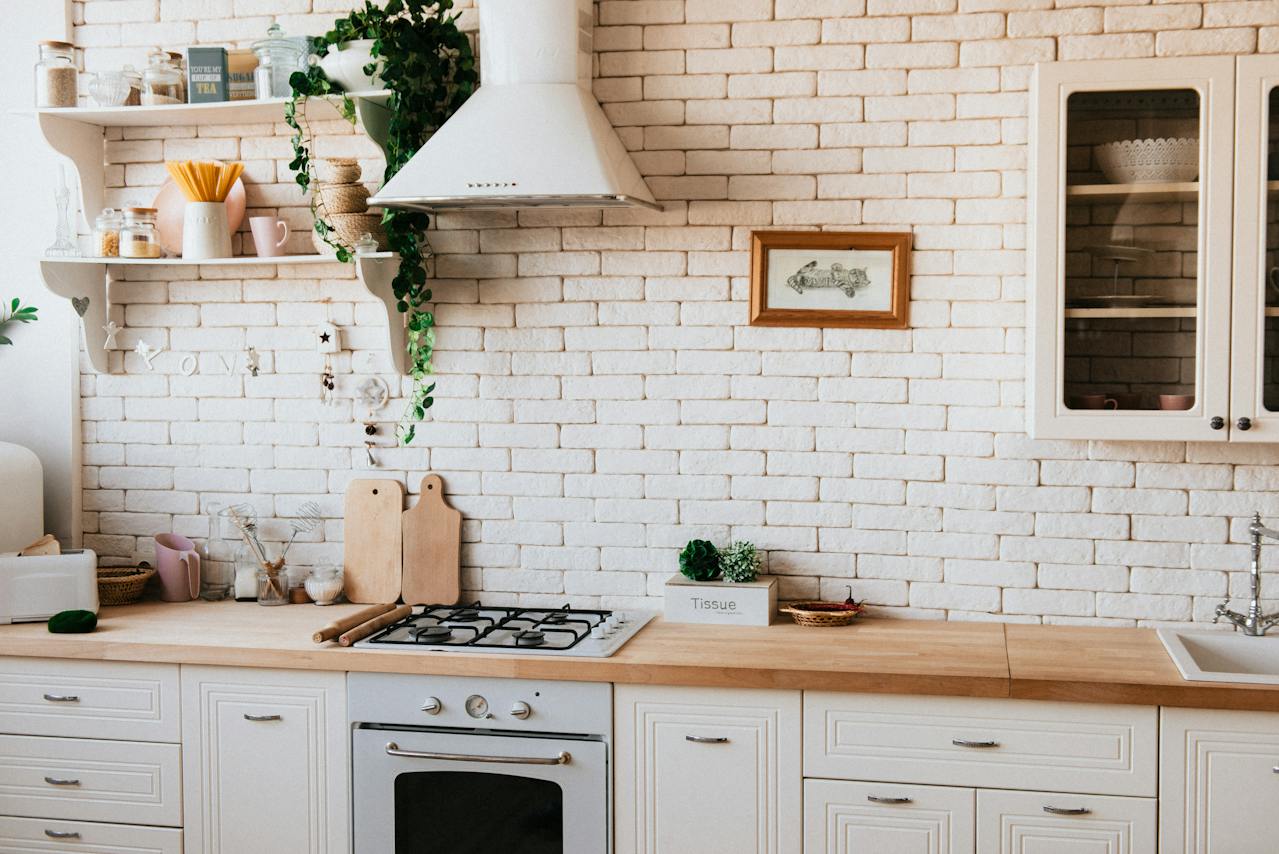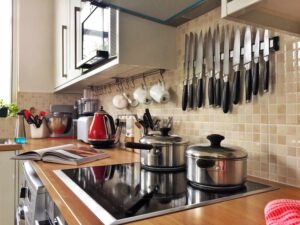To paint kitchen cabinets professionally, first, clean and prep the walls, then apply primer and paint using even strokes and allow ample drying time. When planning to update the look of your kitchen, painting the walls is a cost-effective and relatively easy way to refresh the space.
By choosing the right colors and following a few simple steps, you can achieve a professional-looking paint job that will transform your kitchen. We will guide you through the process of painting kitchen cabinets, from preparing the walls to choosing the right paint and tools.
Whether you’re a seasoned DIYer or a beginner, how to Paint Kitchen cabinets professionally step-by-step guide will help you achieve a beautiful and durable finish that will enhance the overall aesthetics of your kitchen. So let’s get started and bring new life to your kitchen walls!
Clearing Space And Cleaning Walls

Clearing space and cleaning the walls are essential steps in preparing a kitchen for a fresh coat of paint. Before you can transform the heart of your home with a new color, you need to remove appliances and furniture to create a clean canvas. Additionally, thoroughly cleaning the walls of grease and dirt is crucial for achieving a smooth, long-lasting finish. To protect your counters and floors, you must take precautionary measures to ensure they remain untouched by paint splatters. Let’s dive into these important tasks to ensure your kitchen painting project is a success.
Remove Appliances And Furniture
When painting a kitchen, it is vital to start by removing appliances and furniture. Clearing these items from the room not only provides you with more space to work but also prevents any accidental paint damage or spills. Begin by emptying cabinets, shelves, and drawers, taking care to pack fragile or breakable items safely. Move larger appliances, such as fridges and stoves, to an adjacent room or cover them securely with drop cloths to shield them from paint splatters. By creating an open and clutter-free space, you can maneuver more easily and ensure a more efficient painting process.
Clean Walls Of Grease And Dirt
Once the space is clear, it’s time to turn your attention to the walls. Over time, kitchen walls can accumulate layers of grease, dirt, and residue, making it crucial to thoroughly clean them before applying paint. Start by wiping down the walls with a damp cloth or sponge to remove any loose dirt or cobwebs. Next, use a mixture of warm water and mild detergent to scrub away grease splatters and stains. For tougher stains, you can use a diluted mixture of water and vinegar or a specialized grease-removing cleaner. Pay particular attention to areas around the stove and sink, where grease and grime are more likely to accumulate. Rinse the walls with clean water and allow them to dry completely before proceeding to the next steps of your kitchen painting project.
Protect Counters And Floors, Ensuring
While tackling a kitchen painting project, protecting your counters and floors is essential to avoid any unwanted paint splatters or spills. Start by covering your countertops with a sturdy drop cloth, ensuring it is securely taped down to prevent it from shifting during the painting process. For floors, use a combination of drop cloths and plastic sheets, securing them with painter’s tape along the edges to create a protective barrier. By taking these precautionary measures, you can focus on painting your kitchen walls with peace of mind, knowing that your countertops and floors are shielded from potential damage. Remember to periodically check the covers throughout the painting process to ensure they remain in place and adjust them as needed to maintain their protective function.
Choosing The Right Paint
Looking to paint your kitchen? Choosing the right paint is crucial. Follow these key tips to ensure a successful and long-lasting paint job for your kitchen.
Selecting The Appropriate Finish
Choosing the right paint finish for your kitchen is essential to achieve the desired look and durability. It’s important to consider the level of humidity, cooking splatters, and general wear and tear that your kitchen walls will be subjected to. Fortunately, there are a variety of paint finishes to choose from that can withstand these conditions.
When it comes to kitchen walls, a semi-gloss or satin finish is an excellent choice. These finishes offer an easy-to-clean surface and are resistant to moisture, grease, and stains. Semi-gloss paint creates a slightly reflective surface, adding brightness to the room, while satin paint provides a softer sheen for a more subtle effect.
Color Selection For Kitchen Ambiance
The color you choose for your kitchen walls can greatly impact the overall ambiance and mood of the space. When selecting a color, it’s important to consider both your personal style and the desired atmosphere you want to create. Here are some popular color options for kitchen walls:
- Neutral tones: Soft shades of beige, gray, or white are timeless choices for a kitchen as they create a clean and fresh look. They also provide a blank canvas that allows you to experiment with bolder accents through accessories or artwork.
- Warm colors: If you want to add a cozy and inviting feel to your kitchen, warm colors like yellows, oranges, or earthy tones can be great options. These colors can create a welcoming atmosphere and stimulate appetite.
- Cool hues: Blues, greens, and cool grays can give your kitchen a serene and tranquil vibe. They are perfect for creating a calming oasis where you can unwind while cooking or enjoying a meal.
Quality Brands For Durability And Coverage
Investing in quality paint brands ensures not only durability but also optimal coverage for your kitchen walls. The last thing you want after all your hard work is to have the paint start peeling or fading in no time. When it comes to selecting a high-quality paint brand, consider the following options:
| Brand | Features |
|---|---|
| Rust-Oleum | Rust-oleum paints are known for their excellent durability and coverage. They offer a wide range of colors and finishes to suit any kitchen style. |
| INSL-X | INSL-X paintings are renowned for their outstanding quality and longevity. Their paint formulas are designed to resist fading and staining, making them ideal for busy kitchens. |
| DAP | DAP paints provide excellent coverage and durability. They offer a vast selection of colors and finishes, ensuring you can find the perfect match for your kitchen. |
By choosing a reputable brand, you can feel confident that your kitchen walls will not only look beautiful but also stand the test of time. Remember, investing in quality paint is a worthwhile decision that will save you money and effort in the long run.
Applying Primer For Long-lasting Results
When it comes to painting your kitchen walls, applying primer is a crucial step that should not be overlooked. Primer not only helps to create a smooth and even surface, but it also enhances the adhesion of paint, resulting in a more durable and long-lasting finish. In this section, we will explore the importance of primer for kitchen walls and provide you with a step-by-step guide on how to properly apply primer for the best results.
Importance Of Primer For Kitchen Walls
Primer plays a vital role in the longevity of your kitchen paint job. Here are a few reasons why applying primer is essential:
- Sealing: Primer acts as a sealant, preventing moisture and stains from penetrating the walls. This helps to protect the paint and maintain its beautiful appearance for years to come.
- Adhesion: Applying primer improves the adherence of paint to the surface. It creates a rough texture that allows the paint to grip onto the walls, reducing the chances of peeling or chipping.
- Color Enhancement: If you plan to use light-colored paint, primer can help to enhance the vibrancy and true color of the paint by providing a neutral base. It allows the paint to fully showcase its intended hue without interference from the underlying wall color.
- Stain Blocking: Primer has the ability to block out stubborn stains, such as grease marks or water damage. By sealing these imperfections, you can provide a clean canvas for your new paint job.
Step-by-step Primer Application Process
To ensure the primer is applied correctly for optimal results, follow these step-by-step instructions:
- Clean the Walls: Begin by thoroughly cleaning the kitchen walls to remove any dirt, grease, or residue. Use a mild detergent and warm water to scrub the surfaces, and then rinse them well. Allow the walls to dry completely before proceeding to the next step.
- Prepare the Area: Protect the surrounding areas by covering countertops, cabinets, and appliances with drop cloths or plastic sheets. This will prevent accidental spills or splatters from damaging your kitchen.
- Apply Tape: Use painter’s tape to mask off areas that you don’t want to be primed, such as trim, windows, and electrical outlets. This will help to ensure a neat and precise application.
- Mix Primer: Before applying primer, it’s essential to mix it thoroughly. Follow the manufacturer’s instructions on the can for the appropriate mixing technique. This will help to achieve a consistent and uniform application.
- Start Priming: Begin priming the walls using a brush or roller. Start from the top corner and work your way down, using long and even strokes. Apply a thin and even coat to ensure proper coverage. Make sure to reach all corners and edges.
- Allow Drying Time: After applying the first coat of primer, allow it to dry completely. Refer to the manufacturer’s instructions for the recommended drying time. Once dry, check for any bare spots or uneven areas and apply a second coat if necessary.
- Clean Up: Once you have finished priming, clean your brushes and rollers with soap and water or the recommended cleaning solution. Properly dispose of empty cans or leftover primer following local guidelines for hazardous waste.
By carefully following these steps, you can ensure that your primer is applied correctly, providing a solid foundation for your paint and resulting in a long-lasting and beautiful finish for your kitchen walls.
Techniques For Painting Kitchen Walls
When it comes to painting a kitchen, there are various techniques that can make the process easier and more efficient. One important aspect is the painting of kitchen walls, which requires specific skills and attention to detail. In this section, we will discuss two essential techniques for painting kitchen walls: brush and roller techniques, as well as painting around fixtures and cabinets.
Brush And Roller Techniques
Using the right tools and techniques can make all the difference when it comes to painting kitchen walls. Whether you choose a brush or a roller, it is essential to apply even coats of paint for a smooth and professional finish. Here are some tips for each technique:
Brush Technique:
- Select a high-quality paintbrush with synthetic bristles that are suited for the type of paint you are using.
- Start by cutting in the edges of the walls with a brush, using steady and controlled strokes.
- Next, use the brush to apply paint in small sections at a time, working from top to bottom.
- Blend each section smoothly to avoid visible brush marks.
- Ensure that the brush strokes are in the same direction for a consistent finish.
Roller Technique:
- Choose a roller cover with a nap length that matches the texture of your kitchen walls.
- Start by applying paint in a “W” or “N” pattern to cover the entire wall efficiently.
- Work in small sections to avoid drying lines and ensure proper blending of the paint.
- Apply even pressure while rolling to achieve a consistent texture and finish.
- Roll over each section lightly in one direction to smooth out any roller marks.
Painting Around Fixtures And Cabinets
When it comes to painting kitchen walls, it is essential to pay attention to the areas around fixtures and cabinets for a polished look. Here are some tips on how to paint around them:
- Cover fixtures, such as light switches, outlets, and hardware, with painter’s tape to protect them from paint splatters.
- Use a small brush or a mini roller to paint around edges and corners near fixtures and cabinets.
- Take your time and exercise precision to avoid accidentally painting onto fixtures or cabinets.
- If you do get paint on fixtures or cabinets, clean it off immediately with a damp cloth or sponge.
- Consider removing cabinet doors and hardware before painting the walls to make the task easier and more thorough.
- Once the walls are dry, carefully remove the painter’s tape to reveal clean lines and edges.
By utilizing these techniques, you can achieve professional-looking kitchen walls that complement the overall aesthetic of your space. Remember to take your time, use the right tools, and exercise precision for the best results. Happy painting!
Final Touches And Clean-Up
As you near the end of your kitchen painting project, it’s time to focus on the final touches and clean up. These last steps are crucial to achieving a professional-looking paint job that will stand the test of time. In this section, we’ll cover two important aspects: detail work and fixing imperfections, as well as cleaning brushes and storing leftover paint.
Detail Work And Fixing Imperfections
Once the majority of your kitchen walls have been painted, it’s time to turn your attention to the small details that can make a big difference in the overall appearance. Take some time to inspect the walls closely, looking for any imperfections or areas that need additional attention.
If you spot small chips, dents, or smudges, don’t worry! These can easily be fixed with a bit of touch-up work. Start by cleaning the affected area with a mild detergent and water. Rinse it thoroughly and allow it to dry completely. Once dry, you can use a small brush or a foam roller to carefully apply a thin coat of paint to the problem area. Be sure to feather the edges to blend it seamlessly with the surrounding paint.
For larger imperfections, such as holes or cracks, you may need to use a spackling compound or a joint compound. Apply a small amount of the compound to a putty knife and smooth it over the imperfection, ensuring it is completely filled. Allow it to dry according to the manufacturer’s instructions, and then use fine sandpaper to gently sand the area until it is smooth. Once sanded, you can proceed to touch up with paint as mentioned earlier.
Cleaning Brushes And Storing Leftover Paint
Now that the painting is complete, it’s time to properly care for your painting tools and store any leftover paint for future touch-ups. Cleaning your brushes is essential to ensure their longevity and maintain their quality.
Start by removing as much excess paint as possible from the brush by gently scraping it against the edge of the paint can. Fill a bucket or sink with warm soapy water and swirl the brush in it, loosening any remaining paint. Repeat this process until the water runs clear. To ensure all residues are removed, apply a few drops of dish soap directly to the bristles and gently massage them. Rinse the brush thoroughly and reshape the bristles before drying.
When it comes to storing leftover paint, proper sealing, and storing techniques are vital to maintaining its freshness and usability. If the paint is still in its original can, ensure the lid is tightly sealed to prevent air exposure, which can lead to drying and thickening. If you’ve transferred the paint to a different container, make sure the container is airtight and labeled with important information such as the color, sheen, and date of purchase. Store the paint in a cool, dry place, away from direct sunlight and extreme temperatures.
By paying attention to detail work and fixing any imperfections, as well as cleaning brushes and storing leftover paint, you’ll be able to put the finishing touches on your newly painted kitchen. These final steps will not only enhance the overall look of your space but also ensure the longevity of your paint job. Now, step back and admire your beautifully transformed kitchen!
Frequently Asked Questions On How To Paint A Kitchen
How Do I Prepare My Kitchen Walls For Painting?
To prepare your kitchen walls for painting, start by cleaning them thoroughly with soap and water to remove grease and dirt. Next, fill any holes or cracks with spackling compounds and sand them smoothly. Finally, apply a coat of primer to ensure proper adhesion of the paint.
What Type Of Paint Is Best For Kitchen Walls?
The best type of paint for kitchen walls is a semi-gloss or satin finish. These finishes are more resistant to moisture and can be easily wiped clean, making them ideal for high-traffic areas like the kitchen. Additionally, look for paints that are specifically labeled as “kitchen and bath” or “washable” for added durability.
How Many Coats Of Paint Should I Apply To My Kitchen Walls?
In most cases, two coats of paint will provide adequate coverage for kitchen walls. However, if you are painting over a darker color or if the walls have significant imperfections, you may need to apply a third coat for a flawless finish.
Always allow each coat to dry completely before applying the next.
Can I Paint Kitchen Cabinets Without Sanding?
Yes, you can paint kitchen cabinets without sanding, but it is recommended to lightly sand them to ensure better adhesion. If the cabinets have a glossy finish, use a deglosser or liquid sandpaper to remove the shine before painting. This will help the paint adhere better and result in a smoother finish.
Conclusion
Painting your kitchen can be a rewarding DIY project that transforms the look and feel of the space. By following the steps outlined in this guide, you can achieve professional-looking results that will enhance the overall aesthetic of your kitchen.
Remember to prepare the surfaces properly, choose the right paint, and apply the paint evenly for a durable and long-lasting finish. With a little patience and attention to detail, you can enjoy a fresh and updated kitchen that reflects your personal style.





